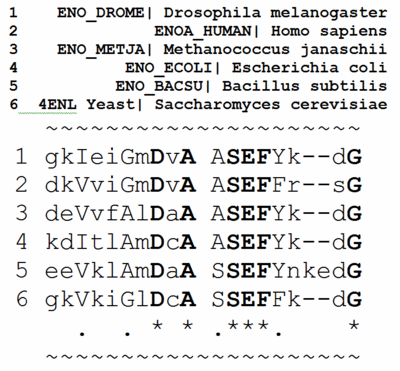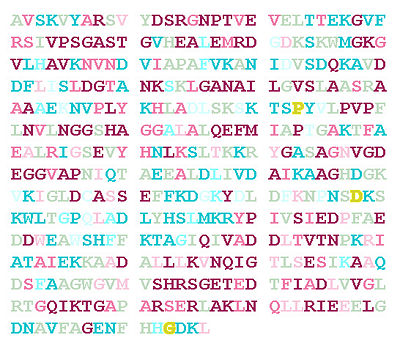Introduction to Evolutionary Conservation (Spanish)
From Proteopedia
Las mutaciones ocurren de manera espontánea en cada generación, produciendo el cambio aleatorio de un aminoácido en una proteína. Aquellos individuos que presentan mutaciones que afectan a funciones críticas de las proteínas, pueden presentar problemas que les dificulten su reproducción. La menor descendencia de los individuos que sufren estas mutaciones dañiñas conduce a la pérdida de dichas mutaciones del acervo génico. Cuando se pierde una mutación dañina, los aminoácidos críticos para la función de la proteína son conservados. Por el contrario, aquellas mutaciones inocuas (o con menor frecuencia beneficiosas), se mantendrán en el acervo génico, dando lugar a variabilidad en aquellos aminoácidos que no son críticos para la función de la proteína.
ExamplesConsider the protein methyl CpG binding protein 2 (MeCP2; UniProt MECP2_HUMAN). Although its function is still unclear, it is expressed throughout the body, and disruption of its function causes problems with brain development and function[1]. Some mutations in MeCP2 cause Rett Syndrome, a severely debilitating congential condition affecting mostly women. These women are unlikely to have children; hence, the mutations in their MeCP2 genes are lost from the human gene pool. Because the mutations are lost, the amino acids at the mutated positions remain unchanged (identical) in the vast majority of people. That is, they are conserved.
Locations of Mutations in 3D ModelThe positions of conserved Arg133 and variable Glu143 are highlighted with yellow halos (). You can see that conserved Arg133 is in intimate contact with the DNA, while variable Glu143 is on the surface, and remote from the contact with the DNA. Finding ConservationSimplistic Analysis of ConservationEvolutionary conservation in proteins is identified by aligning the amino acid sequences of proteins with the same function from different taxa (orthologs). As an example, we'll use the glycolytic enzyme enolase, present in a wide range of taxa. Take a quick look to get an impression of a multiple sequence alignment for ~400 amino acids in enolase for taxa ranging from eubacteria and archaebacteria through yeast, insects, and humans. In the full multiple sequence alignment is one segment highlighted in pink . This segment is enlarged below.
By comparing the amino acids in each column, you will find that some positions are 100% identical (conserved) between taxa. These amino acids are in BOLD UPPER CASE and indicated by an asterisk (*) at the bottom of the column. Other columns are similar but not identical. That is, the general properties of the amino acids in these columns are similar. Hence they are not highly conserved, but there is some evolutionary pressure to keep similar amino acids in these positions, which are marked with UPPER CASE and a period (.) below the column. (The definitions of similar are given at the bottom of the full multiple sequence alignment page.) Finally, there are columns in which at least two of the amino acids are not only different, but also not members of a group of amino acids with similar properties. These are given in lower case, and there is no mark at the bottom of the column. Sophisticated Analysis of Conservation: ConSurfThe above analysis assigns each amino acid in enolase to one of three categories: conserved, similar, or different. This is very simplistic. In contrast, the analysis used in Proteopedia (and in the above image) is sophisticated, using many more sequences, and weighting the impact of each sequence in the multiple sequence alignment according to the phylogenetic tree calculated from the alignment. This sophisticated determination of conservation and variability is done by the ConSurf Servers (see also a summary of their mechanism). ConSurf divides conservation into 9 levels, and colors them as follows:  When ConSurf's colors are applied to the 436 amino acids in the sequence of enolase (based on a multiple sequence alignment containing 150 sequences), this is the result: Notice that the conserved residues are scattered around the sequence with no obvious pattern. However, when the same , they form a conserved patch around the catalytic site (marked with a zinc ion colored green . Conserved surface patches identify functional regions of proteins. Less commonly, patches of high variability may also be functional. (Can you think of situations where high variability would be advantageous?[2]) For instructions on how to identify conserved regions of a molecule of interest, and how to show them in Proteopedia (for example with green links), please see How to see conserved regions. | ||||||||||||||||||||||||



